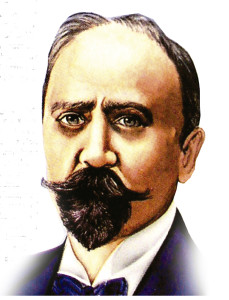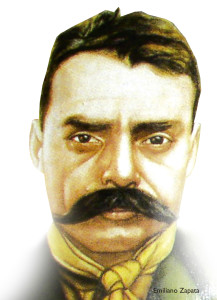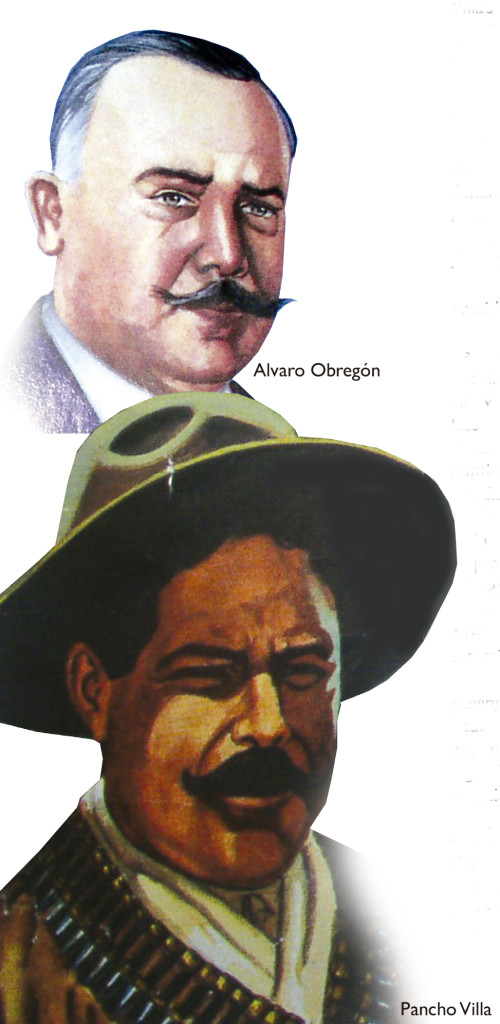The Mexican Revolution, although taking place in the second decade of the twentieth century, is still very much alive in the minds of Mexicans. The bloody civil war pitted the rich against the poor, the clergy against the faithless, and the landowners against the landless. When all was said and done, one million Mexicans had died, almost twice as many as had died in the American Civil War.
The Revolution also lives on largely because of the outsized personalities who were charged with fighting it. The revolutionary generals pepper the historic landscape, not unlike the way Bird and Magic were the very essence of 1980s NBA, and no generals loom larger than Emiliano Zapata, Venustiano Carranza, Alvaro Obregón, and, of course, Pancho Villa. These four men, representing far-flung origins, geographically as well as philosophically, personified the divisions of the Revolution and helped set the course of modern Mexico. Each of these men stood at the vanguard in the struggle for Mexican democracy, and each died a violent, premature death.
The dates for both the beginning and the end of the Mexican Revolution are murky.
There was no assault on Fort Sumter to start the proceedings, nor was there a Treaty of Versailles to mark its ending. Moreover, the term “Revolution” doesn’t refer merely to the fighting, but rather all the drastic changes to Mexican society that were both the fuel for and the result of the fighting.
Given that lack of clarity, the event often cited as the start of the Revolution was Francisco Madero’s issuance of the Plan of San Luis Potosi on November 20, 1910, a call to revolt against the 35-year dictatorship of Porfirio Diaz. Mexico had grown weary of Diaz’s long rule and, with little support from the weak federal army, the dictator fled into exile in 1911 and arranged for Madero’s rise to the presidency.
Madero enjoyed varying degrees of support from Villa, Carranza, Obregón, and
Zapata. Both Villa and Zapata linked their opposition to Diaz to the claims of the poor peasantry, land reform, and a weakening of the entrenched elite in Mexico. There were some important differences between the two: Villa came to prominence leading a gang of bandits in the northern state of Chihuahua. His leadership of armed men came to be useful to the anti-Diaz armies, and Villa’s forces were vital to the seminal battle to oust Diaz at the Battle of Juarez. Much of his political education began as a Madero representative in his home state of Chihuahua. Villa also once had a death sentence commuted by Madero’s brother, so he was understandably close to Madero.
In contrast, a 30-year-old Zapata was elected to lead the defense committee of a small town in the central state of Morelos in 1910. From there, the enormously popular Zapata vaulted himself into a generalship commanding the Southern Liberation Army rebelling against Diaz. From his earliest positions of public prominence, Zapata was agitating for more for Mexico’s landless. He was skeptical that his ally Madero would ever deliver real social change, and ultimately broke with him over his tepid plan for reform.
Although their later actions suggest that Obregón and Carranza had some sense of the
massive inequality that was strangling Mexico, neither one of them was a class
warrior. Both men stayed loyal to Madero throughout his reign, and Carranza served in the prestigious post of Secretary of the Navy and War. Neither Carranza, a well educated man from the border state of Coahuila, nor Obregón, a mayor in the western state of Sonora, developed anything like the cult of personality that developed and still endures around Zapata and Villa. Both were, however, powerful players in the Revolution, and their impact was every bit as deep as that of better known peers.
Regardless of their closeness to the Madero regime, Zapata, Villa, Obregón, and Carranza were all spurred into rebellion by President Madero’s deposition and cold-blooded murder by his military chief, Victoriano Huerta, in February 1913. Uniting under the leadership of Carranza’s Constitutionalist Army, each man distinguished himself in his battles against Huerta’s forces. Defeated in every major engagement against the revolutionary generals, Huerta beat an ignominious path into exile, leaving the capital to the Constitutionalists in July 1914. The rout of Huerta was the high point of unity among the group, but it was not to last. Cracks were already showing in the harmony of the victorious generals.
Zapata was not content with Carranza leading the nation for much the same reasons that he fell out with Madero. Although Carranza established the group land-ownership system knows as the ejido, Zapata sought more profound changes in Mexico’s wealth distribution, and he quickly turned his forces against those headed by Carranza and Obregón.
Villa had battled with Carranza for publicity throughout the defeat of Huerta. Villa was the popular face of the revolution in the United States, and he chafed at Carranza’s attempts to control Villa’s famed Division del Norte. In the decisive battle before Huerta’s flight from power, Villa attacked the central town of Zacatecas against Carranza´s orders in June 1914, delivering a decisive defeat to not only the federal forces, but also to any chances of a peaceful coexistence with Carranza. Obregón and Carranza remained allied—for the moment.
Carranza, now harassed by Zapata to the south and Villa to the north, was forced from the capital. The armies of Villa and Zapata poured into Mexico City from opposite sides in December 1914, allowing for the famous photo op between the two men in the Palacio Nacional.
Carranza was not defeated, but rather regrouping. From April to June 1915, with Obregón at the helm, his forces delivered a series of brutal beatings to Villa’s army in four battles collectively known as the Battle of Celaya. Obregón, who lost an arm in the combat, realized that modern machine guns and artillery gave the defending army an enormous advantage. He wreaked havoc on Villa’s troops, who made charge after charge on his lines, in a dynamic that foreshadowed the bloodshed in Europe that was just beginning to unfold.
While Carranza returned to power following the battles, Villa returned to banditry. He lost the favor of the United States by killing several Americans in 1916 in a railroad robbery and a raid later that year on an American border town, Columbus, New Mexico, that led to 18 American deaths. He became a full-fledged outlaw, wanted by Carranza and American President Woodrow Wilson alike.
Zapata, not enjoying the celebrity or the proximity to the United States of his erstwhile ally, was much less well armed, and he posed less of a threat when not partnered with a potent Villa. He did not fade away, however, continuing to advocate for land reform and redistribution of Mexico’s wealth. Carranza, who had overseen a new constitution in 1917 that formally installed him as president, then placed a bounty on Zapata’s head. That bounty was cashed in 1919, when a colonel, who set up a meeting under the pretense of pledging his services to Zapata, assassinated him instead.
Having relieved himself of two major headaches with the assassination of Zapata and neutralization of Villa, and created the legal basis for the new Mexico with the constitution, Carranza began to contemplate the presidential succession. Here, he erred enormously, bypassing the brilliant General Obregón in favor of Ignacio Bonillas. Obregón and a handful of other heavyweights responded in the typical manner of the revolutionary period: they took up arms. An ally of Obregón nearly assassinated Carranza in Mexico City in 1920. Carranza fled the capital shortly thereafter. He was overrun and assassinated in the central state of Puebla the following month.
Obregón followed in his former boss’s presidential footsteps, serving a full term from 1920 until 1924. Among the revolts and blood feuds carried out by discontented former generals during Obregón’s term, Villa remained peaceful and secluded in Chihuahua. However, he had made a lot of enemies during his colorful career, and in 1923 anonymous assailants assassinated him as he sat in his car. There is speculation as to who ordered the murder (Obregón is often alleged as the mastermind), but there is no one definitive theory.
Obregón, having seen his three foremost rivals all defeated and killed, had seemingly won the game of revolutionary roulette. He engineered his succession just as he wanted, with ally Plutarco Elías Calles elected president at the end of his term. Obregón then returned to the top office four years later, in 1928. A time of greater peace was seemingly in the offing.
But like his revolutionary comrades in arms, Obregón was to die before his time. He died not at the hands of a political or military adversary, but was rather murdered by a seminary student who was upset with his anti-church politics.
Thus was the book closed on Mexico’s greatest quartet of revolutionary generals, each of them murdered, but each enduring as well. The Mexico that lives on today owes a large measure of its identity to the revolutionary generals Villa, Zapata, Carranza, and Obregón.







